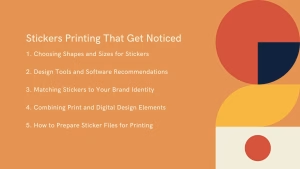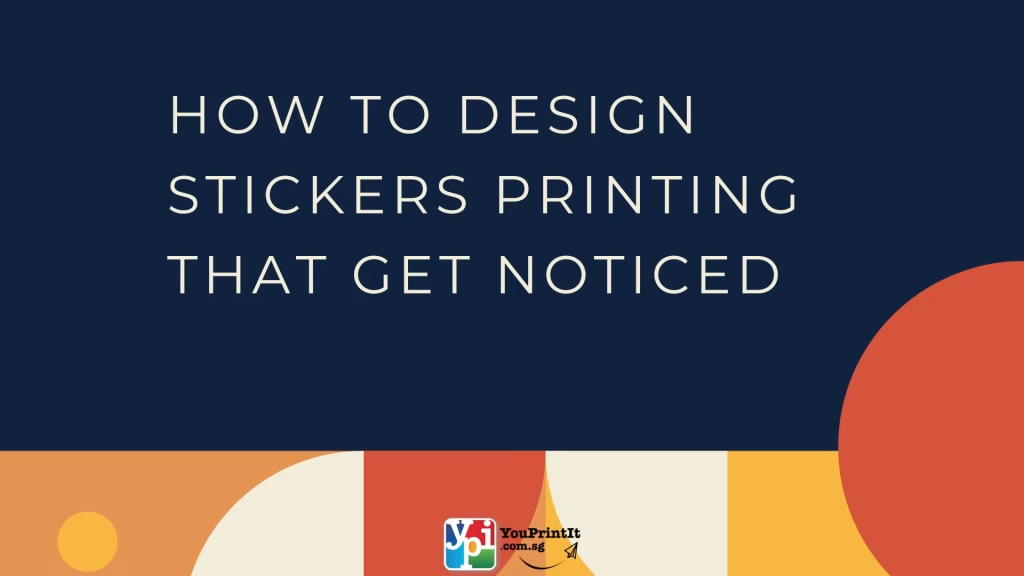Stickers printing have become highly flexible tools for marketing locally. No matter what is being sold for homemade soap, bottled beverages, or gourmet food. Thoughtfully crafted stickers will elevate your marketing and help your brand make a positive and memorable imprint.
For Singapore business owners, stickers are affordable and highly customizable and can be used for a variety of purposes like product labels, advertising, and giveaways. However, for stickers to be of value, there is no underestimating the importance of thoughtful design.
This guide focuses on the crucial elements of attention-grabbing sticker design. We will cover everything from the various shapes and sizes to the artwork supplied for printing.

1. Choosing Shapes and Sizes for Stickers
Designating an appropriate sticker shape and size is one of the most crucial elements in designing effective stickers. Your selection will depend on your branding and packaging.
- Round Stickers : Ideal for minimalist logos and jar seals, coffee cups, and packaging.
- Square Stickers : Provide a modern symmetrical appearance, perfect for labeling boxes or tech items.
- Die-Cut Stickers : Uniquely shaped stickers that follow the contours of your logo or artwork, adding an imaginative and extraordinary aspect.
- Rectangle Stickers : Standard for address labels and product tags containing information.
Size Considerations:
For your sticker size, there’s a tradeoff between seeing it, losing details at a distance, and losing the plot entirely if it’s too big and dominating the packaging.
👉 Pro Tip: Before you settle on a size, do a test print in different dimensions and see how the stickers render on your packaging.
2. Design Tools and Software Recommendations
You do not need to be a qualified designer to generate great stickers. There are lots of design tools available, ranging from simple online applications to more sophisticated packages.
Design Tools:
- Canva: For beginners, and there are lots of free user-customizable templates.
- Adobe Illustrator: Known as the industry benchmark, it is used for designing as well as crafting vector stickers which are easily scaled.
- Affinity Designer: For the trained professionals, it is a cheaper option than Illustrator.
- Procreate (iPad) is excellent for crafting artistic stickers or hand-drawn designs.
Design Tips:
- Design in CMYK colour space for print purposes.
- Keep your resolution not less than 300 DPI.
- Add a 3mm bleed area for printing purposes on the sticker.
Those little design specifics significantly improve the overall print quality.
3. Matching Stickers to Your Brand Identity
Each sticker must be designed according to the character and philosophy of the brand. Stickers can be thought of as an extension of the brand; they should be able to remind the clients of the brand and what the brand stands for.
Branding Considerations:
- Colour Palette: Use the same colours and shades as those of the brand to promote easy identification of the brand.
- Typography: Pick typography that is consistent with the rest of the brand. More playful fonts can be used for artisan and crafty brands and sturdy ones can be used for tech and industrial products.
- Logo Placement: Logos should be visible, but not too big to take over the whole thing. Balance the logo with the rest of the design such as patterns or icons.
For a sticker from a sustainable skincare brand, for instance, one might use earthy colors, simple fonts, and recycled kraft paper for sticker.
👉 Pro Tip: Stickers should be simple and uncluttered. Complicated designs can be off-putting for clients.
4. Combining Print and Digital Design Elements
Sticker design incorporates both print and digital technologies to provide enhanced experiences. This is great from a design perspective for Singapore companies that want to connect with users in print and the internet.
Implement these ideas for engagement:
- QR Codes: Use a QR code that directs users to a webpage, social account, or online shop.
- Social Handles: Use your Instagram or TikTok account to solidify your brand’s presence.
- AR (Augmented Reality) Designs: Innovative brands create AR-enabled stickers that unveil animations or data when scanned.
These suggested digital enhancements will create stickers that are visually inviting and engaging to your customers.
5. How to Prepare Sticker Files for Printing
Designing your stickers is one part of the process. The other involves preparing the correct files so that the stickers can be printed in the correct color, lines and align the cuts properly.
Prior to sending the sticker order, the following must be checked:
- Use Vector Files (AI, EPS, or PDF): The files will be scalable and not lose quality.
- Outline All Text: This will streamline the printing process and prevent mismatched fonts.
- Add Bleed and Safe Zone: Include a bleed of 3mm and keep important elements in the safe zone.
- Convert to CMYK: Use the CMYK color profile for accurate printing.
- Check File Size and Resolution: A print resolution of 300 DPI is optimal.
FAQs About Sticker Design and Printing
1. What’s the best material for stickers?
Vinyl is the most popular choice for durability and water resistance. Paper stickers are great for short-term or eco-friendly uses.
2. How long do stickers last?
High-quality vinyl stickers can last 2–5 years, depending on exposure to sunlight and humidity.
3. Can I print full-color designs?
Yes. Most printing companies offer full CMYK color printing for vibrant, detailed designs.
4. Are custom shapes more expensive?
Die-cut stickers cost slightly more due to custom cutting, but they significantly improve visibility and brand recall.
5. Can I print small quantities?
Yes. Many Singapore-based printers offer small-batch printing, ideal for startups or limited-edition products.
Ready to bring your sticker designs to life? 🎨
Contact YouPrintIt Singapore today for Custom your stickers printing tailored to your brand. Choose from durable vinyl, eco-friendly paper, and premium finishes. All designed to make your products stand out!
Anis Sofia is an SEO content writer specializing in crafting optimized articles, blogs, and website content. With expertise in keyword research, on-page SEO, and content strategy, Anis helps businesses build brand visibility and connect with their target audience through engaging, search-friendly writing.




